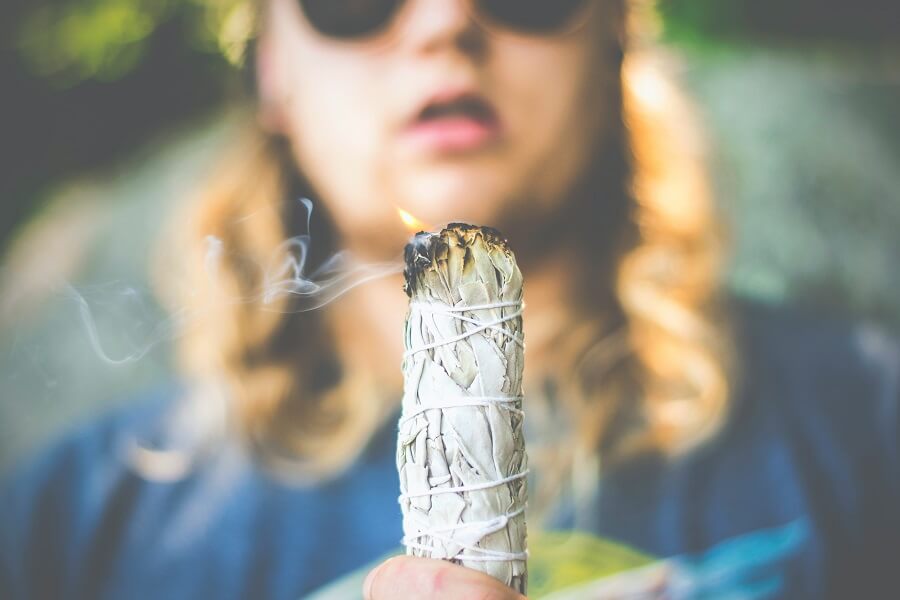If you’re sensitive to spiritual energy, you may notice that sometimes, when you enter a room, you can sense something feels “off” in the space. Smudging, or burning white sage, is a centuries-old spiritual practice to purify a space of negative energy (and it could also make your room smell fresh and revived as all-natural candles can do).
We could all use more peace and positivity, whether that comes from saging to meditation to self-care. Is saging your home the best way to clear negative energy and restore your space? It depends on your intention and connection to the practice. Here’s how smudging sage can invite more positive energy into your home.
What is smudging?
Burning sage doesn’t mean holding a match to the herbs you pick up at the grocery store. White sage is a pale, intensely aromatic plant sacred to various Indigenous nations in California and Mexico. Some smudging practices also use blue sage, sweetgrass, and cedar.
People practice smudging by placing dried herbs in a safe container (like an abalone shell or a special bowl), lighting the herbs, and blowing the flame out so an ember is left. The fragrant smoke is considered to have purifying properties.
The person then wafts the smoke throughout the space, often with a feather, and invites positive energy into the room, urging negative energy to leave through open doors and windows. Ventilation is vital for smudging to work properly.
Smudging is considered a form of medicine and is accompanied by prayer and thoughtful intention to cleanse the space and the people participating in the ritual. Smudges are often (but not always) led by spiritual leaders or elders.
Benefits of burning white sage
The main purpose of burning white sage is to spiritually cleanse a home or other space. If white sage is part of your cultural or spiritual practice, you may feel a strong connection to the plant and feel positive energy benefits after burning it. White sage also has a distinct aroma, which many find relaxing or therapeutic.
Is smudging with white sage safe?
Burning sage (or anything else) as an energy-clearing practice produces smoke. As a general rule, inhaling smoke can cause irritation to the lungs in people or animals. If anyone in your home has respiratory conditions or fragrance sensitivity, you may need to have them be out of the house for a smudging practice.
Smudging with white sage also involves setting fire to loose leaves or a bundle or “wand,” which can be a fire hazard. It’s essential to have a fire-safe container to hold smudging herbs and have a plan in case you need to put out an unplanned fire quickly.
White sage smudging controversy

Seeking pure and positive spiritual energy is a beautiful thing. Unfortunately, some mainstream wellness practices have a pattern of taking from other cultures without honoring their sacred significance and exploiting them rather than joining an existing practice. White sage smudging isn’t free from these problematic trends.
Overharvesting white sage in sacred sites is a problem. White sage isn’t currently endangered or threatened, but poaching and overharvesting are serious issues to consider before buying sage. After all, intention matters throughout a smudging practice, so unethical or unsustainably sourced sage could be said to carry negative energy.
There aren’t clear, well-enforced guidelines for harvesting white sage, so even if a retailer claims to harvest respectfully and sustainably, there’s no way for you to confirm that’s true.
The other problematic element of smudging is that many wellness influencers carry the practice away from its spiritual and cultural roots. Some Indigenous people consider smudging a “closed practice” meant only for the cultures it originated in. Others say saging is OK for outsiders when it’s done respectfully. Your respect, intention, and spiritual connection matter to determine whether you actually cleanse your home’s energy or just burn smoke.
Alternative options to purify your home’s energy
If burning white sage is a practice you want to pursue, the best way to get started is to connect with Native-led organizations in your area. Shamans and Elders in your community can guide and teach you. Building genuine ties with a Native community is the ideal route to developing a practice grounded in the authentic spirit. You may also find Native-run companies that can vouch for respectful, sustainable white sage harvest.
If we’re being honest, many of us may not have the strong, personal tie to make a white sage practice be “for us” — and that’s OK. White sage smudging is not the only spiritual cleansing practice. There are other ways you can enjoy some spiritual self-care and restore positive energy in your home without being part of potentially controversial trends.
Here are some to consider:
- Lavender. This is fragrant and spiritually associated with purity, peace, and positive energy. It may also be easier to find sustainably sourced lavender than sage.
- Juniper. This herb is connected to Ancient Norse purification rituals, so if your family ancestry reaches Scandinavia, this may tie into your cultural roots.
- Rosemary. This is used as a cleansing, purifying herb to burn in several cultures, including parts of Europe and Mexico.
- Candles. If you’re nervous about handling an open flame and burning dried herbs, burning candles can be part of a beneficial spiritual practice.
- Holy water. Some Christians may wish to use holy water to bless a space (which is also wholly smoke-free).
- Crystals. Stones with cleansing and spiritual properties are a smoke-free way to add a purifying element to your home.
Whatever you use to rebalance the energy in your home, thoughtful intentions and a respectful commitment to sustainability will start you on the right path toward a meaningful and positive practice.





